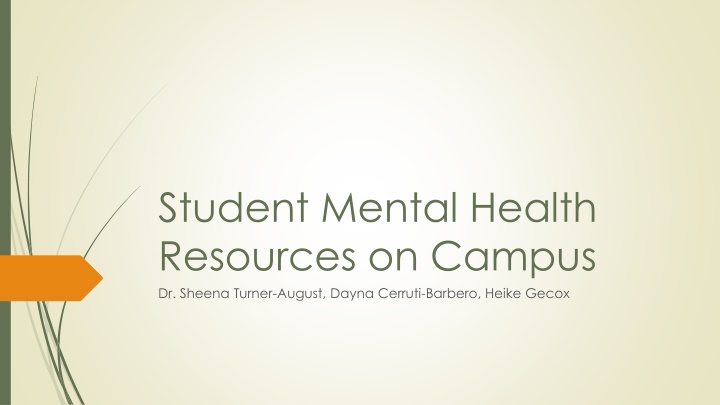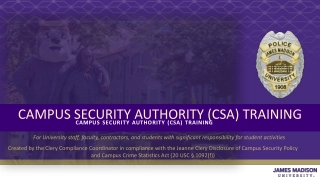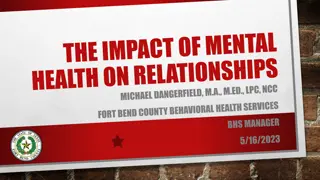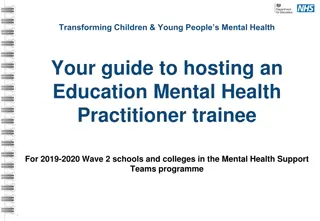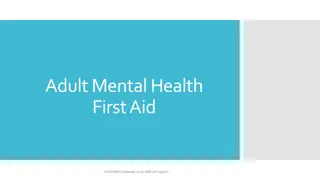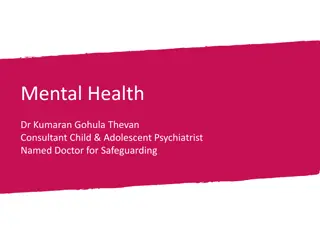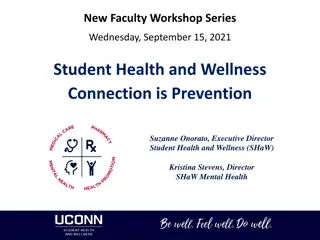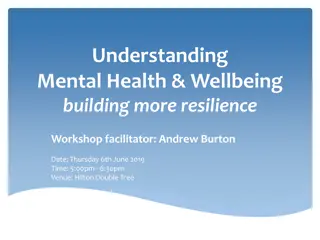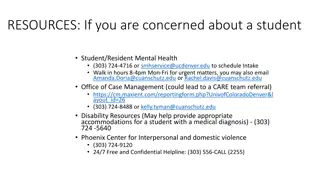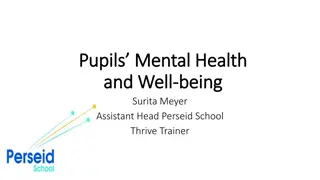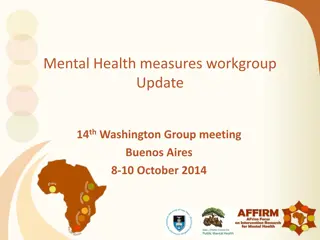Student Mental Health Resources on Campus Workshop Overview and Team Introduction
Workshop provides an introduction to the team offering behavioral health services, review of resources, signs of psychological distress, case scenarios, and intervention strategies. Meet the team including Dr. Sheena Turner-August, Dayna Cerruti-Barbero, and Heike Gecox, who are dedicated to supporting student mental health. Explore the Behavioral Intervention Resource website for guidelines and reporting procedures. Learn about Kognitos Training, an online simulation for faculty, staff, and students. Recognize signs of students in need and know how to guide them to appropriate resources.
Download Presentation

Please find below an Image/Link to download the presentation.
The content on the website is provided AS IS for your information and personal use only. It may not be sold, licensed, or shared on other websites without obtaining consent from the author.If you encounter any issues during the download, it is possible that the publisher has removed the file from their server.
You are allowed to download the files provided on this website for personal or commercial use, subject to the condition that they are used lawfully. All files are the property of their respective owners.
The content on the website is provided AS IS for your information and personal use only. It may not be sold, licensed, or shared on other websites without obtaining consent from the author.
E N D
Presentation Transcript
Student Mental Health Resources on Campus Dr. Sheena Turner-August, Dayna Cerruti-Barbero, Heike Gecox
Workshop Overview Introduction to the Team and Behavioral Health Services overview Review of BIRT Review of online resources & kognitos training Signs of Psychological Distress Case Scenarios and appropriate Interventions Q&A
Meet the Team Dr. Sheena August-Turner: Las Positas College Psychology professor, Behavioral Health Outreach Program Coordinator. Dayna Cerruti-Barbero: Health Service Association of California Community College Mental Health and Wellness Association liaison, the Northern California regional representative, Integrative mental health advocate for medical programs, Director of Student Health and Wellness Services Heike Gecox: General Counselor, International Student s Counselor, Marriage Family Intern Supervisor MFT Associates: Cheryl Dickinson: MFT associate provider, Chill and Chat facilitator, 13 reasons why not smart shop series lecturer Peter Hartman: MFT associate provider, adjunct psychology professor
Behavioral Intervention Resource website Resources & guidelines for recognizing a student in need Reporting a student of concern Campus emergency contact for crisis Community behavioral health crisis resources Behavioral health resources http://www.laspositascollege.edu/birt/index.php
Kognitos Training Online training simulation designed to educate our faculty, staff, and students about best practices in supporting Each training takes 30-60 minutes to complete and is structured as a virtual practice environment where users learn by engaging in interactive role-play conversations with emotionally responsive student avatars. Trainings are available at no-cost to all California community college faculty, staff, and students. https://www.kognitocampus.com/faculty/ccc
Recognizing a Student in Need You may be the first one to recognize when a student needs help, and can guide him or her to professional resources. The following examples of student s appearance, behavior, and expressions of distress are cause for concern. Unusual Appearance: Swollen or red eyes A change in personal hygiene or dress Dramatic weight loss or gain Marked Behavior Changes: Poor performance and preparation Excessive absences or tardiness Repeated requests for special consideration, especially when accompanied by a change in attitude Unusual or changed pattern of interaction Avoids participation Dominates discussions Excessive anxiety when called upon Disruptive behavior Problems with roommates or family Exaggerated emotional responses that are inappropriate to the situation Depressed, lethargic mood Hyperactivity or very rapid speech Strange or bizarre behavior indicating a loss of contact with reality
Vignette # 1 Ronald Smith is an adjunct instructor at the local community college, teaching an evening History class for the first time. The class only meets Monday evenings from 7:00 PM to 9:50 PM. Although the class meets in the evenings and many of his students report coming straight form work, most of his students are very engaged and greatly participate during class discussions. One of his students, Bob, however, makes it at point to continually interrupt him or other students during class. Professor Smith has asked him several times not to interrupt, to no avail. Tonight seems no different. Professor Smith has to ask Bob once again to not interrupt him, but this time the response is different. Bob jumps out of his chair and starts yelling at Professor Smith, telling him in expletives that he most certainly will not do that. Bob is making verbal threats toward his instructor. The other students in the class are visibly shaken by Bob s outburst.
Questions? How should Professor Smith manage the situation in the class room? What resources are available to him? Are there specific institutional procedures in place that he should follow?
Vignette #2 Dr. Lindsey Powell is an English instructor at Las Positas Community College. She is a popular and highly respected instructor, by both students and her colleagues alike. Dr. Powell has noticed that the grade one of her students, Michelle, is slipping. Michelle had a great start to the semester and was always one of the top students in class, but has turned in remedial work for the last two assignments. Dr. Powell informs Michelle that they need to talk about her slipping grade and that she is concerned. Michelle does approach Dr. Powell right after the next class and asks to speak to her, which she is more than happy to do so. Michelle starts to tell Dr. Powell that her personal life is in turmoil, her parents are getting a divorce and she will no longer receive any financial support from them. The news is devastating to her, because now she can no longer afford to transfer to San Jose State University to pursue her dream, a degree in journalism. Michelle informs Dr. Powell she has been depressed about the situation for a while now and feels there is no alternative. Michelle tells her that she just wants to die. The situation is hopeless and she no longer sees a future for herself.
Questions? How should Professor Smith manage the situation in the class room? What resources are available to him? Are there specific institutional procedures in place that he should follow?
